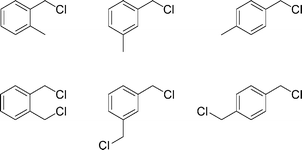Photoacid generators (PAG) are chemical systems where light absorption renders strong acid formation, typically with quantum yields greater than one. Many compounds bearing halogen atoms are reported to produce hydrogen halides upon photolysis. Here, α-chloroxylene derivatives (ortho, meta and para) were subject of a photolysis study in order to: (i) determine the operative mechanism, (ii) identify the products formed and (iii) quantify the amount of HCl formed. Product structure and quantum yields of HCl formation where determined for the photolysis of α-chloro-o-xylene (1), α-chloro-m-xylene (2), α-chloro-p-xylene (3), α,α′-dichloro-o-xylene (4), α,α′-dichloro-m-xylene (5) and α,α′-dichloro-p-xylene (6) in apolar (benzene, cumene, ethylbenzene, toluene and isooctane) and polar (methanol, n-propanol, isopropyl alcohol) solvents. Some of these compounds were analysed by laser flash photolysis in argon-purged isooctane as solvent to examine the possible reaction intermediates involved. The observed products are derived from typical radical reactions like recombination, dimerization and hydrogen abstraction from the starting compound or from solvents. The formation of HCl is expected as the result of C–Cl homolysis followed by hydrogen abstraction by chlorine atom. The results showed yields ranging from 1.2 to 18, depending on the conditions used. These numbers indicate the potential use of these compounds as PAG systems for the deep UV region.


 Please wait while we load your content...
Please wait while we load your content...